How to Make a Metal Shipping Container Into a Human Connector
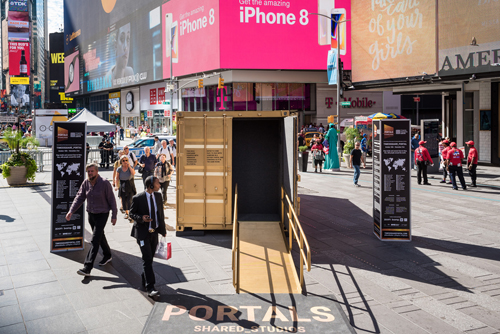
By Kirsten Nelson, Special to AVIXA
There is a supremely human-centric conference room temporarily taking meetings on the Times Square pedestrian plaza. And like something out of an acoustical consultant’s dream, it doesn’t have any windows — except for one digitally delivered pane that provides a view far beyond the mayhem of the crowds outside to far-flung locations around the world.
Called the TimesSquare_Portal, this compact, rectilinear immersive audiovisual experience lives in a shipping container customized by Shared_Studios to seamlessly connect humans across the world. As the latest extension of an art project that was launched in December 2014, this streamlined example of full-scale videoconferencing rested on prime real estate for seven weeks thanks to the Times Square Arts program.
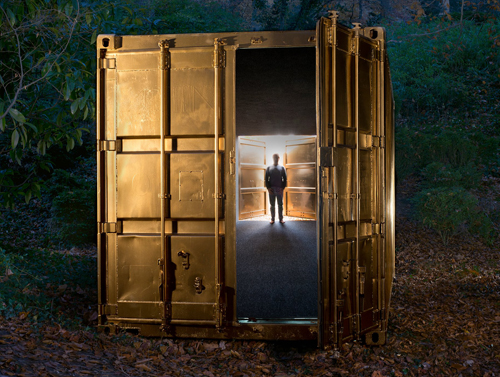 One of some 20 temporary and permanent sites around the world, the self-sufficient rectangular Portal doesn’t require much bandwidth, and yet the immersive audiovisual connection is beyond adequate. Lifelike, human-scale video representations arrive latency-free from the far end, while near-end participants are unobtrusively captured via a simple centrally-located camera peeking through a small square cut into a wall-sized projection surface. The audio connection, too, is perfectly synched with a global audience that is becoming increasingly well-versed in cloud-based video calls. And the acoustics are super smooth, thanks to an interior completely padded in architectural wool.
One of some 20 temporary and permanent sites around the world, the self-sufficient rectangular Portal doesn’t require much bandwidth, and yet the immersive audiovisual connection is beyond adequate. Lifelike, human-scale video representations arrive latency-free from the far end, while near-end participants are unobtrusively captured via a simple centrally-located camera peeking through a small square cut into a wall-sized projection surface. The audio connection, too, is perfectly synched with a global audience that is becoming increasingly well-versed in cloud-based video calls. And the acoustics are super smooth, thanks to an interior completely padded in architectural wool.
The combination of simple technology and quiet spaces that were visually duplicated at either end of the video connection to produce the appearance of one unified room made it simple for people to connect easily and find common ground.
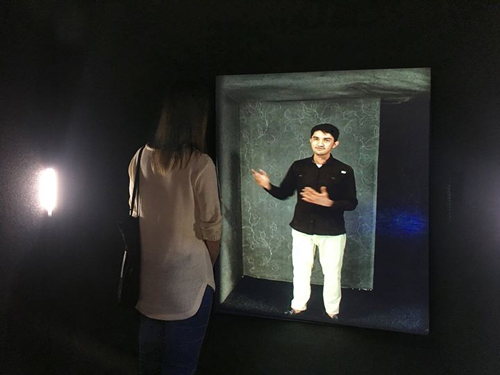 “The original idea was that people went in for 20 minutes and had a one-on-one conversation with a stranger about daily life,” explained Shared_Studios founder and Creative Director Amar Bakshi. “But people went in, and they were much more moved than we anticipated. They came out weeping, they came out giddy. They came out with a lot of new ideas.”
“The original idea was that people went in for 20 minutes and had a one-on-one conversation with a stranger about daily life,” explained Shared_Studios founder and Creative Director Amar Bakshi. “But people went in, and they were much more moved than we anticipated. They came out weeping, they came out giddy. They came out with a lot of new ideas.”
Soon after the initial two Portals connected New York with Tehran, a full slate of educational and artistic programming began to evolve as local curators enabled community members to collaborate with their counterparts worldwide. Before they knew it, Bakshi and Shared_Studios co-founder and Director of Global Development Michelle Moghtader were setting aside their respective careers in law and journalism to meet the surprising demand for their efficient and engaging mode of connecting people.
The DIY innovation of these ever-multiplying Portals began with one empty shipping container and a lot of creative construction in the backyard of Bakshi’s parents’ home. While neighbors looked on suspiciously (“Is he living in there?”), he set to work customizing simple, portable electronics and materials that could be easily shipped or duplicated around the world.
First having settled on the Portals’ universal burnished gold exterior and dark gray interior colors and fabrics, Bakshi set to work on the technology component of the project. He consulted with his optical engineer uncle to customize a camera lens that would maximize scale at minimal distance. Some custom software ingenuity on the back end processed the images for display via a short-throw projector onto a square surface treated with projection paint.
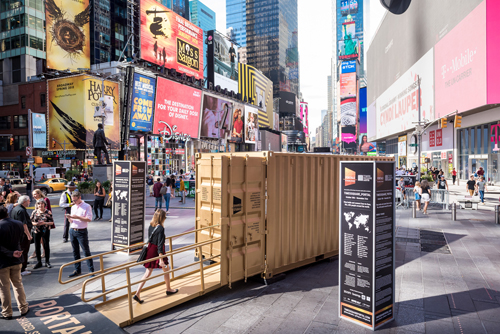 Video plays a role outside the Portals, too. Hundreds of hours of what Shared_Studios calls “vertical video” has been collected from the communities hosting Portals. Centered on universal themes like beauty, athletic pursuits, creative endeavors and more, these vertical video images are played back on a 9x16-oriented flat panel LED display outside the Portal itself. So those walking by might be drawn in by images of someone getting a haircut in Erbil, Iraq, or kids playing soccer in Malaga, Spain, or any number of countless music or dance performances from the global scene.
Video plays a role outside the Portals, too. Hundreds of hours of what Shared_Studios calls “vertical video” has been collected from the communities hosting Portals. Centered on universal themes like beauty, athletic pursuits, creative endeavors and more, these vertical video images are played back on a 9x16-oriented flat panel LED display outside the Portal itself. So those walking by might be drawn in by images of someone getting a haircut in Erbil, Iraq, or kids playing soccer in Malaga, Spain, or any number of countless music or dance performances from the global scene.
Surprisingly wide arrays of creative and educational interactions are produced by each Portal, with the possibilities rapidly expanding as host communities adopt the new form of free-flowing interaction. Such was the case with a Portal that took up residence in Milwaukee’s 53206 ZIP code, which bore the unfortunate distinction of having the highest incarceration rate of black men in the U.S. A documentary project connected community leader Lewis Lee with the Portals project, and suddenly sparks of community innovation were flying.
“At first it started off as people talking about criminal justice — how people feel about police in their communities, talking about solutions and ways that we thought we could improve it,” Lee said. “But as we started to engage and actually be in the machine every day, having the discussions, we found that they became more therapeutic.”
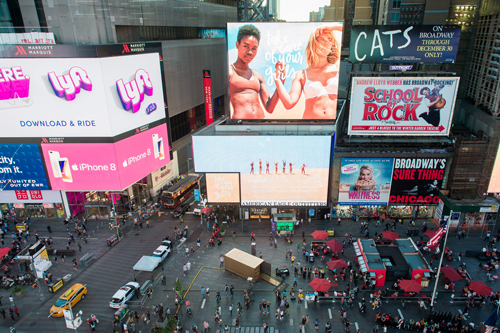 Visiting New York as a guest curator for the TimesSquare_Portal, Lee described how he saw the Milwaukee Portal used as a collective emotional release, which prompted him to think of more ways to utilize the space and its connection to the world. Soon thereafter, the Milwaukee Portal was initiating global talent shows, entrepreneurial vision sharing, and maybe most particularly, educational exchanges between local students and those of the Greenwich Academy in Connecticut. Going deeper on its original purpose, the Milwaukee Portal was also host to negotiations between rival gangs, and the launching pad for Lee’s Milwaukee Fatherhood initiative, which used the portal to connect hundreds of men on Father’s Day.
Visiting New York as a guest curator for the TimesSquare_Portal, Lee described how he saw the Milwaukee Portal used as a collective emotional release, which prompted him to think of more ways to utilize the space and its connection to the world. Soon thereafter, the Milwaukee Portal was initiating global talent shows, entrepreneurial vision sharing, and maybe most particularly, educational exchanges between local students and those of the Greenwich Academy in Connecticut. Going deeper on its original purpose, the Milwaukee Portal was also host to negotiations between rival gangs, and the launching pad for Lee’s Milwaukee Fatherhood initiative, which used the portal to connect hundreds of men on Father’s Day.
“I like to call it a global clubhouse,” Lee said, “because it was our way of expressing ourselves to the world. We were able to give our ideas to the world.”
As the Portals project continues to expand, AV technology partners are bolstering the endeavor with support. Biamp came on board as microphone partner and providing its Devio collaborative conferencing system, and Zoom joined as the official connection partner worldwide.
Now Shared_Studios is seeking to make technology improvements with additional partners. Goals include unifying the technology blueprint with a single projector or LED display manufacturer, and potentially replacing the current invisible in-wall speakers with a new solution.
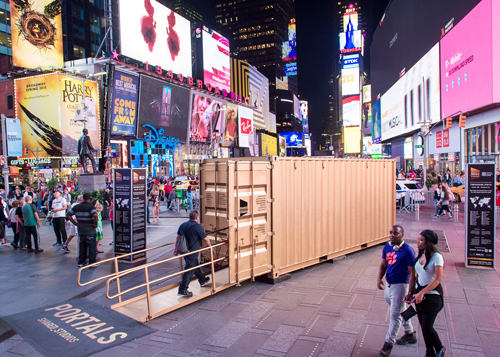 Each addition to the technological setup will be implemented with the intention to maintain the simplicity that has driven the project from the start. As with the best audiovisual installations, refinement is reflected by the seamlessness of experience with the gear. “We’re essentially taking really basic stuff but then making a moment out of it,” Bakshi said. “We’re trying to be a space where people can create their own meaning. People don’t come to a Portal knowing exactly what they want to get out of it. They’re coming out of a basic human curiosity that we don’t always think is there, but it really is. We’ve had something like 75,000 people come through and have dialogues.”
Each addition to the technological setup will be implemented with the intention to maintain the simplicity that has driven the project from the start. As with the best audiovisual installations, refinement is reflected by the seamlessness of experience with the gear. “We’re essentially taking really basic stuff but then making a moment out of it,” Bakshi said. “We’re trying to be a space where people can create their own meaning. People don’t come to a Portal knowing exactly what they want to get out of it. They’re coming out of a basic human curiosity that we don’t always think is there, but it really is. We’ve had something like 75,000 people come through and have dialogues.”
Many of those people stay for a much longer time than they expected, Bakshi noted, having discovered a comfortable place to connect. “When we started, people were asking why anyone would do this,” he recalled. “Now everyone’s asking how we’re going to scale. We are never going to be in everybody’s house. That’s not the point. But we could be in a lot of communities and be a public space that does a lot of interesting things and that benefits from people being linked to one another.”
Portals will be a space to watch as more organizations approach Shared_Studios to inquire about adding educational programming, community content, and arts offerings. The way technology is at the forefront and yet in the background of these human connections is proof of how audiovisual technology can meet needs and generate new purpose through ease of use.





